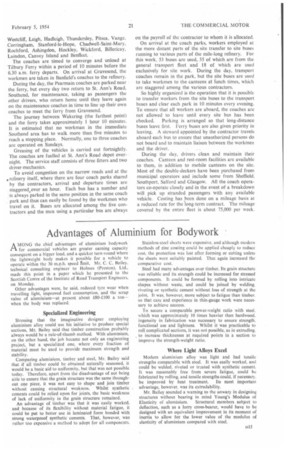Advantages of Aluminium for Bodywork
Page 55

If you've noticed an error in this article please click here to report it so we can fix it.
AIvIONG the chief advantages of aluminium bodywork for commercial vehicles are greater earning capacity consequent on a bigger load, and a quicker turn-round where the lightweight body makes it possible for a vehicle to operate within the 30 m.p.h. speed mit. Mr. C. C. Bailey, technical consulting engineer to Holmes (Preston), Ltd., made this point in a paper which he presented to the Scottish Centre of the Institute of Road Transport Engineers, on Monday.
Other advantages were, he said, reduced tyre wear when travelling light, improved fuel consumption, and the scrap value of aluminium—at present about 00-£100 a ton— when the body was replaced.
Specialized Engineering Stressing that the imaginative designer employing aluminium alloy could use his initiative to produce special sections, Mr. Bailey said that timber construction probably always would be a rule-of-thumb method. With aluminium, on the other hand, the job became not only an engineering project, but a specialized one, where every fraction of material must be used to provide maximum strength and stability.
Comparing aluminium, timber and steel, Mr. Bailey said that if all timber could be obtained naturally seasoned, it would be a basic aid to uniformity, hut that was not possible today. Therefore, apart from the disadvantage of not being able to ensure that the grain structure was the same throughout one piece, it was not easy to shape and join timber without causing structural weakness. Whilst synthetic cements could be relied upon for joints, the basic weakness of lack of uniformity in the grain structure remained,
An advantage of timber was that it was easily worked, and because of its flexibility without material fatigue, it could be put to better use in laminated form bonded with strong waterproof synthetic cements. That, however, was rather too expensive a method to adopt for all components.
Stainless-steel sheets were expensive, and although modern methods of zinc coaling could be applied cheaply to reduce cost, the protection was lost after forming or cutting unless the sheets were suitably painted. That again increased the comparative cost.
Steel had many advantages over timber. Its grain structure was reliable and its strength could be increased for stressed components. It could be formed by rolling into intricate shapes without waste, and could be joined by welding, riveting or synthetic cement without loss of strength at the joint. It was, however, more subject to fatigue than timber. so that care and experience in thin-gauge work were necessary to achieve success.
To secure a comparable power-weight ratio with steel. which was approximately 10 times heavier than hardwood, ingenuity in fabrication was necessary to ensure strength. functional use and lightness. Whilst it was practicable to roll complicated sections, it was not possible, as in extruding. to increase thicknesses at required points in a section to improve the strength-weight ratio.
Where Light Alloys Excel Modern aluminium alloy was light and had tensile strengths comparable with steel. It was easily worked, and could be welded, riveted or treated with synthetic cement. It was reasonably free from severe fatigue, could be fabricated by rolling, and tensile strengths could, if necessary be improved by heat treatment. Its most important advantage, however, was its cxtrudability.
Mr. Bailey sounded a warning to the unwary in designing structures without bearing in mind Young's Modulus of Elasticity of aluminium. Structural members subject to deflection, such as a lorry cross-bearer, would have to be designed with an equivalent improvement in its moment of inertia to allow for the lower value of the modulus of elasticity of aluminium compared with steel.








































































































